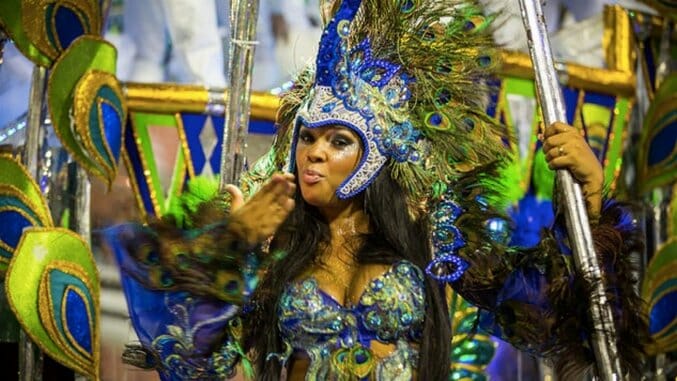deGeneration X: Carnaval Gone Wild in Salvador, Brazil

Rio de Janeiro hosts the most famous Carnaval in Brazil, but the title for wildest Carnaval goes to the colonial city of Salvador in Bahia state. Unlike the stadium-enclosed processions in Rio, the Salvador parade routes take place in the city streets with the public taking part. This is why some travelers argue that you watch Carnaval in Rio and live it in Salvador. Having thrown down on Copacabana and Ipanema Beaches the previous year, my girlfriend and I headed to Salvador for the 2011 party.
Being an active part of Carnaval sounds amazing on paper, but from the opening night, it felt like being thrown into a ring with wild animals. There was fighting, thieving, puking, groping and even a blow job in the hostel stairwell. Seemingly everyone—men and women, straight and gay, local and tourist—ate up the atmosphere like a Viagra hotbox prowling like predators and abandoning all standards. With a lack of public bathrooms, a steady stream of urine filled the gutters, yet our favorite public urinator was an American letting loose next to the hostel door. When my girlfriend and I exited, he turned midstream and declared, “Your bitch is fuckin’ hot, dude.” Mama must be proud.
Bahian Carnaval is not a spectator sport, and you will definitely get dirty. In fact, the pro tip is to bring shoes you don’t mind tossing later because that urine smell won’t come off.
My girlfriend and I arrived the night before Carnaval after spending several mosquito-bitten days in the Brazilian wetlands. Accommodation costs skyrocket during Carnaval, and many locals pack their apartments with bunk beds and rent them out for about $100 per night. Travelers can save money by staying in Pelourinho, the UNESCO-honored colonial center perched high in Cidade Alta (upper city), but the old town is separated from the lower city by a massive set of stairs and an elevator that, during Carnaval, demands Disneyland-like waits. Our desired neighborhood, Barra, was a commercial area at the tip of the peninsula, and one of the three main Carnaval circuits (Barra to Ondina via Avenida Oceânica) begins here. For a grand, we landed beds in an apartment-turned-hostel with a rooftop deck, but the place only had one bathroom for about 20 guests. This meant you might have to wait through multiple showers before taking your morning piss.
On the first day, my girlfriend and I met the other travelers. Joining us in the makeshift hostel were our friend Adri from Colombia, four British women, two male creepers from Argentina, an epically annoying older American who sometimes wore indigenous garb, two lovely couples from Toronto and an American living in South Korea with a fiancé he failed to mention until the final night.
“I hope he doesn’t ask us to connect on Facebook,” I whispered to my girlfriend as the older American described where he got his indigenous … dress? Then one of the British ladies dropped the first shocker.
“I’m not going to shower all week,” said an attractive London Brit of Italian heritage.
“Are you trying to keep the guys away?” I asked.
“Do you think I came all this way to keep guys away?” she asked with disbelief. No clarification or explanation followed.
Carnaval (Carnival in Spanish-speaking countries) traditionally starts six days before Ash Wednesday in either February or March (February 5 to 10 for 2016). The Rio Carnaval soundtrack primarily consists of different samba styles, but Salvador is more diverse with samba-reggae, frevo, maracatu and axé, among other genres. Bahia state is mostly Afro-Brazilian, arguably claiming the largest black population outside Nigeria, and the music, dress and dance reflect the rich multicultural heritage. The 2016 Carnaval theme for Pelourinho is 100 Years of Samba celebrating the centennial anniversary of Baiano’s “Pelo Telefone; the first-known samba recording and the smash hit of Rio Carnaval 1917. Samba is the best-known Brazilian music and dance style, and its name and influences come from West African countries like Angola via the slave trade.
Salvador is also the birthplace of the_ trios elétricos_, giant trucks and floats that transport music artists through the city streets. The first such trio rolled through Barra nearly 70 years ago, but the rolling parties, or blocos, are now a regular part of Bahian Carnaval. Blocos headline the Barra-Ondina and Campo Grande-Avenida Sete parade routes, and each truck features a roped-off section to keep the area isolated. To access the protected section, people must purchase an abadá—i.e., a colorful shirt with a specific bloco design—for between $50 and $500. In 2011, participating artists included Brazilian stars Timbalada, Daniela Mercury and Banda Eva and DJ sets by David Guetta and will.i.am. A few years back, K-pop phenom Psy even helmed a bloco. The abadá makes it easier to follow a particular bloco, but anyone on the street can participate outside the ropes as pipoca, or “popcorn.” To watch all the blocos in relative peace, many people pay up to $700 to party in a camarote, i.e., venues overlooking the main parade routes. The price usually includes alcohol, drinks and a DJ, but many venues have limited vantage points that early-arriving patrons tie up for the entire night.
-

-

-

-

-

-

-

-

-

-

-

-

-

-

-

-

-

-

-

-

-

-

-

-

-

-

-

-

-

-

-

-

-

-

-

-

-

-

-

-








































